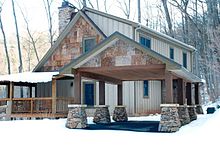Double Carports Storage Buildings Barns Sheds Garages
Double Carports If your looking for a compact way to bring a metal carport and steel storage unit to your property, then you’ve found the best solution.
A building like this is essentially a double carports with part of it enclosed. Side entry is a stylish option as shown here.
Contact our sales department at 386-277-2851 about the Double Carports metal car shed for sale that interests you.
One example of the many common types of modern carports sold on the market. This particular one is a stand alone model.
A carport is a covered structure used to offer limited protection to vehicles, primarily cars, from the elements. The structure can either be free standing or attached to a wall. Unlike most structures a carport does not have four walls, and usually has one or two. Carports offer less protection than garages but allow for more ventilation.
Quoting from the Carport Integrity Policy for the Arizona State Historic Preservation Office:
As early as 1909, carports were used by the Prairie School architect Walter Burley Griffin in his design for the Sloan House in Elmhurst, Illinois (Gebhard, 1991: 110). By 1913, carports were also being employed by other Prairie School architects such as the Minneapolis firm of Purcell, Feick & Elmslie in their design for a residence at Lockwood Lake, Wisconsin. In this instance, the carport was termed an “Auto Space” (Gebhard, 1991: 110). The late architectural historian David Gebhard suggested that the term “carport” originated from the feature’s use in 1930s Streamline Moderne residences (Gebhard, 1991: 107). This term, which entered popular jargon in 1939, stemmed from the visual connection between these streamlined residences and nautical imagery. In the 1930s through the 1950s, carports were also being used by Frank Lloyd Wright in his Usonian Houses; an idea that he probably got from Griffin, a former associate.
Modern carports are typically metal (steel, tin, or aluminum) and are modular in style in the USA, while remaining flat-roofed permanent structures in much of the rest of the world. The carport is considered to be an economical method of protecting cars from the weather and sun damage, and tens of thousands are installed in the USA alone each year.
The term carport was coined by renowned architect Frank Lloyd Wright, when he began using the carport for the first of his “Usonian” homes; the house of Herbert Jacobs, built in Madison, Wisconsin, in 1936.
In describing the carport, he said to Mr. Jacobs, “A car is not a horse, and it doesn’t need a barn.” He then added, “Cars are built well enough now so that they do not require elaborate shelter.” Looking back at life in 1936, it is easy to imagine automobiles prior to this time were not completely water tight; the era of robotic-assembly, advanced materials, and perfect closure lines was still 50 years in the future.
The carport was therefore a cheap and effective device for the protection of a car. Mr. Jacobs added: “Our cheap second-hand car had stood out all winter at the curb, often in weather far below zero (Fahrenheit). A carport was a downright luxury for it.”



